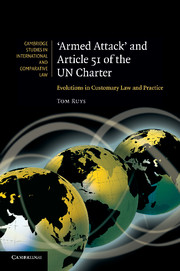Book contents
- Frontmatter
- Contents
- Acknowledgment
- Table of abbreviations and abbreviated citations
- Selected case law, legislation and related documents
- Introduction
- 1 The methodological debate and the quest for custom
- 2 ‘Armed attack’ and other conditions of self-defence
- 3 The ‘armed attack’ requirement ratione materiae
- 4 The ‘armed attack’ requirement ratione temporis
- 5 The ‘armed attack’ requirement ratione personae
- 6 What future for the ‘armed attack’ criterion?
- Index
- References
6 - What future for the ‘armed attack’ criterion?
Published online by Cambridge University Press: 10 January 2011
- Frontmatter
- Contents
- Acknowledgment
- Table of abbreviations and abbreviated citations
- Selected case law, legislation and related documents
- Introduction
- 1 The methodological debate and the quest for custom
- 2 ‘Armed attack’ and other conditions of self-defence
- 3 The ‘armed attack’ requirement ratione materiae
- 4 The ‘armed attack’ requirement ratione temporis
- 5 The ‘armed attack’ requirement ratione personae
- 6 What future for the ‘armed attack’ criterion?
- Index
- References
Summary
The customary boundaries of self-defence
In this Section, we again confront the research question posed at the outset of our study: to what extent have recent evolutions in the international security environment, and reactions thereto in terms of State practice and opinio iuris, altered the customary boundaries of self-defence, both de lege lata and de lege ferenda? To answer it, we will bring together the different pieces of the puzzle, while keeping footnotes to a healthy minimum.
A word of caution
First, a word of caution. Throughout this study we have proceeded on the conviction that the primary material for interpreting and supplementing Article 51 UN Charter consists in relevant customary practice. We have made extensive use of ‘concrete’ custom, viz. States' physical practice and the concomitant exchanges of legal claims and counter-claims, but also of ‘abstract’ evidence – in particular the travaux of the UNGA Definition of Aggression. The case law of the ICJ and legal doctrine have been employed as a subsidiary source of interpretation.
While we believe this is the proper (positivist) method, its application is not without difficulties for various reasons. First, in spite of the abundance of verbal practice in the records of the UN Security Council and General Assembly, the idenfication and weighing of State practice and opinio iuris is not a matter of exact science.
- Type
- Chapter
- Information
- 'Armed Attack' and Article 51 of the UN CharterEvolutions in Customary Law and Practice, pp. 511 - 550Publisher: Cambridge University PressPrint publication year: 2010

